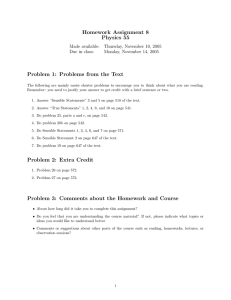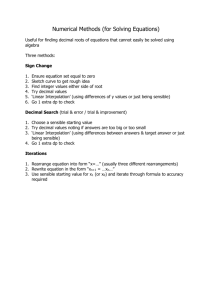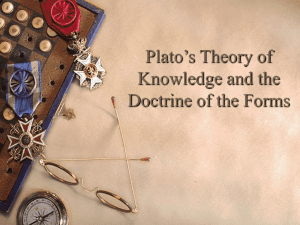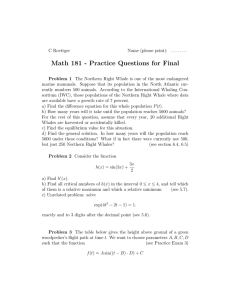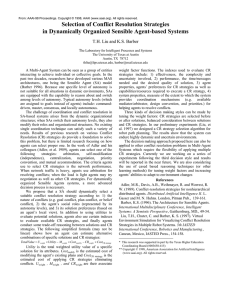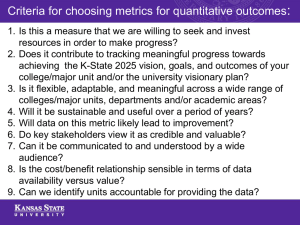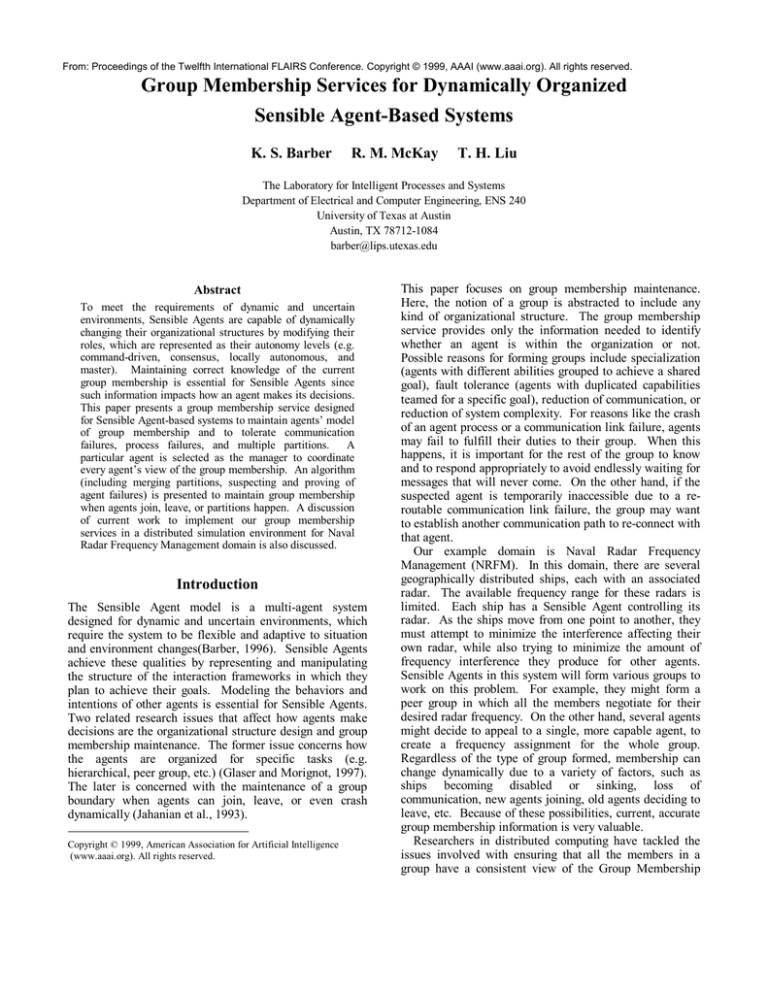
From: Proceedings of the Twelfth International FLAIRS Conference. Copyright © 1999, AAAI (www.aaai.org). All rights reserved.
Group Membership Services for Dynamically Organized
Sensible Agent-Based Systems
K. S. Barber
R. M. McKay
T. H. Liu
The Laboratory for Intelligent Processes and Systems
Department of Electrical and Computer Engineering, ENS 240
University of Texas at Austin
Austin, TX 78712-1084
barber@lips.utexas.edu
Abstract
To meet the requirements of dynamic and uncertain
environments, Sensible Agents are capable of dynamically
changing their organizational structures by modifying their
roles, which are represented as their autonomy levels (e.g.
command-driven, consensus, locally autonomous, and
master). Maintaining correct knowledge of the current
group membership is essential for Sensible Agents since
such information impacts how an agent makes its decisions.
This paper presents a group membership service designed
for Sensible Agent-based systems to maintain agents’ model
of group membership and to tolerate communication
failures, process failures, and multiple partitions.
A
particular agent is selected as the manager to coordinate
every agent’s view of the group membership. An algorithm
(including merging partitions, suspecting and proving of
agent failures) is presented to maintain group membership
when agents join, leave, or partitions happen. A discussion
of current work to implement our group membership
services in a distributed simulation environment for Naval
Radar Frequency Management domain is also discussed.
Introduction
The Sensible Agent model is a multi-agent system
designed for dynamic and uncertain environments, which
require the system to be flexible and adaptive to situation
and environment changes(Barber, 1996). Sensible Agents
achieve these qualities by representing and manipulating
the structure of the interaction frameworks in which they
plan to achieve their goals. Modeling the behaviors and
intentions of other agents is essential for Sensible Agents.
Two related research issues that affect how agents make
decisions are the organizational structure design and group
membership maintenance. The former issue concerns how
the agents are organized for specific tasks (e.g.
hierarchical, peer group, etc.) (Glaser and Morignot, 1997).
The later is concerned with the maintenance of a group
boundary when agents can join, leave, or even crash
dynamically (Jahanian et al., 1993).
Copyright © 1999, American Association for Artificial Intelligence
(www.aaai.org). All rights reserved.
This paper focuses on group membership maintenance.
Here, the notion of a group is abstracted to include any
kind of organizational structure. The group membership
service provides only the information needed to identify
whether an agent is within the organization or not.
Possible reasons for forming groups include specialization
(agents with different abilities grouped to achieve a shared
goal), fault tolerance (agents with duplicated capabilities
teamed for a specific goal), reduction of communication, or
reduction of system complexity. For reasons like the crash
of an agent process or a communication link failure, agents
may fail to fulfill their duties to their group. When this
happens, it is important for the rest of the group to know
and to respond appropriately to avoid endlessly waiting for
messages that will never come. On the other hand, if the
suspected agent is temporarily inaccessible due to a reroutable communication link failure, the group may want
to establish another communication path to re-connect with
that agent.
Our example domain is Naval Radar Frequency
Management (NRFM). In this domain, there are several
geographically distributed ships, each with an associated
radar. The available frequency range for these radars is
limited. Each ship has a Sensible Agent controlling its
radar. As the ships move from one point to another, they
must attempt to minimize the interference affecting their
own radar, while also trying to minimize the amount of
frequency interference they produce for other agents.
Sensible Agents in this system will form various groups to
work on this problem. For example, they might form a
peer group in which all the members negotiate for their
desired radar frequency. On the other hand, several agents
might decide to appeal to a single, more capable agent, to
create a frequency assignment for the whole group.
Regardless of the type of group formed, membership can
change dynamically due to a variety of factors, such as
ships becoming disabled or sinking, loss of
communication, new agents joining, old agents deciding to
leave, etc. Because of these possibilities, current, accurate
group membership information is very valuable.
Researchers in distributed computing have tackled the
issues involved with ensuring that all the members in a
group have a consistent view of the Group Membership
(GM). Various approaches with different features have
been proposed. The main idea is that processes multicast
messages to group members to track membership changes
(e.g. new processes join, existing processes leave).
However, certain issues need to be addressed before
applying existing GM techniques to Sensible Agent
systems. These include the types of failures tolerated, the
mechanism used to reach agreement on group membership
changes, and security. To address these issues, we propose
a partitionable group membership algorithm for Sensible
Agents based on existing research results. A brief
background review is provided in the following section.
Solution requirements are described in Section 3. Section
4 presents our approach and algorithms. The effects of GM
services on Sensible Agent behavior are discussed in
Section 5. Section 6 introduces our implementation
environment. Finally, Section 7 concludes the paper and
discusses future work.
Related Research
Interaction with other
system agents
Interaction with
the Environment
SENSIBLE AGENT
CONFLICT
RESOLUTION
ADVISOR
ACTION
PLANNER
PERSPECTIVE
MODELER
AUTONOMY
REASONER
Perception of
Environment and
external agents
Autonomy
Requests
SYSTEM MODEL
Sensible Agents
Many domains challenge agent-based systems to be
adaptive and flexible while providing consistently efficient
and effective problem solutions. The Sensible Agent
model has been proposed to answer the demands of these
domains(Barber, 1996). Sensible Agents are capable of
Dynamic Adaptive Autonomy, meaning they have the
ability to form groups, called Autonomy Groups, to work
on joint goals. Each goal an agent is working on is
assigned an Autonomy Level, which specifies the
Autonomy Group structure. Several typical structures are
named: Master/Command-driven – hierarchical, Consensus
– peer group, and Locally Autonomous – agent works
alone. By forming these groups, Sensible Agents modify
the overall problem-solving organization of their system.
These modifications serve to increase system flexibility
and maintain or improve solution quality.
As shown in Figure 1, Each Sensible Agent is composed
of four major modules (Barber, 1996). The Action Planner
(AP) module solves domain problems and executes
problem solutions.
The Autonomy Reasoner (AR)
determines the appropriate autonomy level for each goal.
It is also responsible for establishing the goal’s
corresponding Autonomy Group. The Conflict Resolution
Advisor (CRA) identifies, classifies, and generates possible
solutions for conflicts occurring between the self-agent and
other agents. The Perspective Modeler (PM) contains the
agent’s explicit model of its local (subjective) viewpoint of
the world. The overall model includes the behavioral,
declarative, and intentional models of the self-agent (the
agent who’s perspective is being used), other agents, and
the environment. Other modules within the self-agent can
access the PM for the current status of its models.
Figure 1 The Architecture of Sensible Agent
Group Membership in Distributed Computing
In the Distributed Systems research community, a large
amount of work has developed group membership and
communication services for distributed computer
processors and processes, such as Isis(Birman and van
Renesse, 1994), Horus(van Renesse et al., 1996),
Transis(Dolev and Malki, 1996), Totem(Moser et al.,
1996), Newtop(Ezhilchelvan et al., 1995), and
Relacs(Babaoglu et al., 1995), which offer different
guarantees about the reliability and order of message
delivery. The main idea is that processes multicast
messages to group members to track membership changes
(e.g. new processes join, existing processes leave).
A group expels members that have failed. There are
many types of failures a process can be exposed to. Perfect
accuracy of failure detection cannot be guaranteed due to
the fact that there is no message delay limitation (in time)
for asynchronous distributed systems and it is impossible
to distinguish slowness from a crash. The concept of a
failure suspector has been devised to encompass all of the
impossibility(Babaoglu et al., 1997). Every process has a
failure suspector, which is responsible for informing its
associated process of the suspected failures of other group
members. The failure suspector may have some wrong
suspicions, resulting in the expulsion of a live member.
Different design assumptions about partitions have been
proposed. The primary partition model assumes there is
only one main partition, or set of processes, that can
communicate and work together. Agents outside the
primary partition are considered crashed and are ignored.
The group membership protocols developed in (Ricciardi
and Birman, 1995) make this assumption. The multiple
partition model (e.g. (Babaoglu et al., 1997)) allows the
initial group to be instantly divided into several subgroups
that cannot communicate with each other.
These
subgroups are still expected to make progress on their own,
and will merge if they discover a way to communicate.
Requirements and Assumptions
This section discusses our requirements for a group
membership algorithm for Sensible Agents. First, the
algorithm has to tolerate multiple partitions. Since it could
be the case that none of these subgroups has a majority of
the original group, the typical mechanism used in a
primary partition model to reach agreement, voting, cannot
be used here. Any subgroup without a majority of
members would deadlock, unable to decide on a course of
action.
The second set of requirements is the types of failures our
algorithm should tolerate. We consider two points of
failure – processes and communication links. By process,
we mean a Sensible Agent, and by link, we mean a oneway communication channel between two processes that
can fail independently of the processes. For both of those,
we use the most common failure model in the distributed
computing community, the crash failure. By crash failure,
we mean a complete and permanent stoppage of all
functionality, with no warning. Notably missing from our
failure model is the Byzantine failure, or arbitrary incorrect
behavior. This failure type is out of the scope of this
paper.
Third, the cost of expelling a live agent from the group is
high.
Therefore, a mechanism is required to give
suspected agents a chance to prove that they are still alive.
This will help decrease the number of agents wrongly
expelled.
However, we should not diminish our
algorithm’s ability to remove members that actually have
failed or are no longer reachable.
Finally, we assume group members have a secure method
for verifying the identity of other agents. Our proposed
implementation of this assumption is a security service
layer that provides message encryption services (e.g.
public-key, secret-key) for our group membership
service(Schneier, 1996).
Approach
In the proposed group membership algorithm, every group
contains a distinguished agent called a manager(Ricciardi
and Birman, 1995). This agent is responsible both for
coordinating the agents’ views of the membership and for
being the group’s contact with agents outside the group.
The use of this agent, as opposed to having all group
members broadcast all messages, reduces the
communication costs of our algorithm from O(n2) to O(n).
Incoming Event
Response
from Manager:
receive submit(add(newmember))
from Manager:
receive commit(add(newmember))
from Manager:
receive submit(remove(currentmember))
from Manager:
receive commit(remove(currentmember))
Pre-commit, send back to Manager
ack(submit(add (newmember)))
Commit to new view that includes newmember
from currentmember:
receive object(submit(remove(currentmember)))
from Manager:
receive retract(submit(remove(currentmember)))
From Manager:
Receive commit(disband(newmanager))
Forward to Manager
From Failure Suspector:
Suspect(1, currentmember)
from Failure Suspector:
suspect(2, currentmember)
from Failure Suspector:
suspect(2, currentmanager)
from nonmember:
receive request(*)
Notes
Should always come after
submit(add newmember)
Attempt to forward the message to currentmember
Commit to new view that excludes currentmember
If received with no accompanying
submit, currentmember voluntarily
left the group
Reset suspicions of currentmember
1. Form self-group, of which this agent is the manager
2. Attempt to merge with the group having newmanager
as its manager
Send submit(suspect(currentmember)) to
currentmember, or Send
submit(suspect(currentmember))
to Manager
Send submit(suspect(currentmember)) to Manager
The 1 in the suspect event
indicates that this agent has not
yet attempted to verify its
suspicion with the suspected party
The 2 in the suspect event
indicates that this agent has
already attempted to verify its
suspicion with the suspected party
Special case of the above
procedure when currentmember is
currentmanager
1. Form self-group, of which this agent is the manager
2. Continue trying to make progress by itself until it
encounters another partition, then send
request(add(thisagent)) to the manager of that partition.
Forward to Manager
* is any type of group membership
change, such as add, merge, etc.
Table 1: Group Membership Algorithm for Non-Manager
Incoming Event
Response
Notes
from currentmemberA:
submit(suspect(currentmemberB))
1. Broadcast submit(remove (currentmemberB)) to all
members
2. Wait until either
a. Receive object(submit(remove(currentmemberB)))
b. Receive ack(submit(remove(currentmemberB)))
from all live members and some
predefined time t has passed
from currentmemberB:
Reset suspicions of currentmember, broadcast
object(submit(remove(currentmemberB))) Retract(submit(remove(currentmemberB)))
to all members
Broadcast commit(remove(currentmemberB))
Receive
ack(submit(remove(currentmemberB)))
to all members
from all live members and
some predefined time t has passed
from currentmember:
Broadcast commit(remove(currentmember)) to all
request(remove(currentmember))
members
from nonmembermanager:
Start merge procedure
receive
(see paragraph below)
request(merge(nonmembermanager))
Send submit(suspect(currentmember)) to
from Failure Suspector:
suspect(1, currentmember)
currentmember
from Failure Suspector:
suspect(2, currentmember)
Same as if manager received
submit(suspect(currentmemberB)) from
currentmemberA
If manager has reason to believe that
currentmemberB is still alive, it may
simply inform currentmemberA of this fact.
It may propose a new communication
route to currentmemberA.
Decision of whether to allow a new agent
into the group is made by the application
layer.
The 1 in the suspect event indicates that
this agent has not yet attempted to verify
its suspicion with the suspected party
The 2 in the suspect event indicates that
this agent has already attempted to verify
its suspicion with the suspected party
Table 2: Group Membership Algorithm for Manager
Agents report their suspicions of other agents to their
manager and if there is no evidence to object to that
suspicion, the manager will broadcast that suspicion.
When agents receive such a broadcast, they will send an
acknowledgement back to their manager (otherwise they
will be suspected as well) and attempt to forward this
message to the suspected agent, using the available
communication links. To address our first and third
requirements, we have devised a mechanism using an
objection and proof methodology. Using this mechanism,
any agent receiving a message indicating the group’s
suspicion of it has the option of objecting to the manager.
When the manager receives such an objection, it will
broadcast a retraction. Our use of this mechanism helps
motivate our second set of requirements, because we then
allow the group to assist those agents experiencing
communication difficulties (slow or failed link) by
searching for new communication links.
When an agent loses its connection with its manager
(either the manager crashes, communication link brakes, or
partitions happen), it will form a temporary single agent
group of which it is the manager. Then this manager tries
to contact other agents/partitions, with the objective of
merging with them. After an unstable time period, all the
reachable partitions will have merged. By this method, we
can guarantee there is always a manager and therefore the
group membership service is always available. The
following tables describe our algorithms.
When two partitions become aware of each other, they may
execute a merge. The first step in a merge is to decide
which current manager will be the manager of the new
group. This can be decided in a variety of ways, such as a
manager rank, number of members in each partition, etc.
Once this is decided, the members of the partition that does
not contain the new manager are told by their current
manager to disband and join the new partition individually.
This avoids the problem of getting all the members to
agree on joining the new partition.
Effects of Group Membership on Sensible
Agents
The provision of a GM service affects the way a Sensible
Agent behaves. This change in behavior can be traced to
each of the modules in an agent. The GM service is
located inside the Perspective Modeler, which provides the
information to the other agents about the current
membership for all the groups of which the self-agent is a
member.
For any multi-agent Autonomy Group, current information
on group membership is vital to the Action Planner’s
function. Its plan may be completely different depending
on the agents in the group. For example, consider a
Consensus Group that has already decided on a group plan
for its joint goals. If a member dies after having been
assigned some tasks, the entire group plan may need to be
re-thought to account for this loss.
The Autonomy Reasoner may decide that the agent should
leave an Autonomy Group (typically for some penalty).
One good reason for leaving an Autonomy Group is if vital
members have failed. For example, if an agent is
command-driven for a goal and its master fails, it should
not simply remain idle waiting for instruction. It should
reevaluate its desired Autonomy Level, perhaps entering
into a new agreement with other agents. This type of
flexibility is facilitated by current information about who is
still alive in a group.
The kinds of conflict resolution strategies offered by the
Conflict Resolution Advisor vary widely depending on the
types of Autonomy Groups the agent is a member of. For
example, if it is in a Consensus Group, a conflict with
another agent may require negotiation. However, a
conflict with a fellow command-driven agent may best be
resolved by appealing to the superior intellect of a master
agent. In addition to the types of groups of which an agent
is a member, the actual membership of those groups may
be a factor in choosing a conflict resolution strategy. For
example, a fellow Consensus Group member may be
skilled at mediating conflicts, so the CRA might suggest
taking advantage of that.
Implementation
This section introduces the Sensible Agent Testbed, which
is the Sensible Agent implementation integrated with a
distributed simulation environment (Figure 2). We use the
Object Management Group’s (OMG) Common Object
Request Broker Architecture (CORBA) standards and the
OMG Interface Definition Language (IDL) to formally
define the interactions among agents and their modules.
The use of IDL permits continued Sensible Agent
evolution in an implementation-language-independent
manner and facilitates parallel research initiatives within
the framework of an integrated distributed object system.
Sensible Agent modules and the environment simulator are
implemented as CORBA objects that currently
communicate through the Xerox Inter-Language
Unification (ILU)(Xerox, 1998) distributed object
environment (i.e. Object Request Broker, ORB). The
Sensible Agent System Interface (SASI) provides a
functional wrapper around the internal modules. This
implementation allows the integration of multiple
implementation languages (C++, Java, Lisp and ModSIM)
simultaneously on Solaris, WindowsNT and Linux
platforms. Additionally, ORB support of the CORBA
Internet Inter-Orb Protocol (IIOP) standard will allow the
connection of external ORBs to the Sensible Agent
Testbed, further enhancing its extensibility. The use of
IIOP combined with the OMG’s CORBAServices Object
Naming Services (COSNaming) allows the presentation of
a public interface to the Sensible Agent Testbed,
permitting external entities to connect with the testbed for
experimentation.
In the simulation Naval Radar Frequency Management, a
group of ships moves from a point out in the ocean to a
point on the coast. Along the way, they form and dissolve
various groups to work on their goal of minimizing radar
interference and their other joint goals. Sometimes the
dissolution of a group is due to the fact that the goals have
been accomplished. However, storm may disrupt the
agent’s communication. In this situation, the agents realize
that the system has become partitioned, so they revert to
their self-groups in order to avoid deadlock and continue
Sensible Agent
Environment
AP
SASI
CRA
SASI
AR
PM
IGS
ILU CORBA ORB
IIOP
3rd Party ORB
3rd Party
SASI
User
Interface
Figure 2: Sensible Agent Testbed Implementation
Architecture
making progress. When the ships can communicate again,
they have the option of merging their partitions. Currently
we are working to fully implement our group membership
service. Further analysis of the performance data collected
will help to validate our algorithm.
Conclusion
This paper presented a group membership service for a
Sensible Agent-based system to maintain correct and
consistent models of group boundaries. Based on the
existing group membership techniques, our algorithm uses
an objection and proof mechanism to improve safety (live
agents will not be kicked out) without sacrificing liveness
(the failed agent will eventually be kicked out).
The group membership service helps Sensible Agents carry
out their goals. Since a Sensible Agent’s planning and
execution behaviors are highly dependent on the
interaction among agents, the correct maintenance of the
membership helps agents to react correctly to
organizational changes. These changes might include: new
agents joining a group (to pursue a shared goal), existing
agents leaving the group (either due to being expelled or
simply deciding to leave), and the formation of multiple
partitions (a group is partitioned into several sub-groups).
Sensible Agents already posses the ability to form new
Autonomy Groups in response to these changes, however,
they still require a service that provides notification of
changes in the group’s composition – our group
membership service.
Future work in this area will extend to the maintenance of
more complex organizational structures, including groups
within groups (abstractional hierarchy) and overlapping
groups. One of the main reasons for forming hierarchical
groups is to enable command and information abstraction.
We would also like to expand our failure model
consideration to include Byzantine failures, or arbitrary
behavior.
In addition, simulation and additional
experimental data will be further analyzed regarding the
impact on performance of the autonomy level changes as
well as organization changes. The information gained
during execution regarding perceived performance of the
agent can be used to help Sensible Agents make better
decisions about autonomy levels.
Acknowledgements
The work presented here is sponsored in part by the Texas
Higher Education Coordinating Board project #003658415
Reference
Babaoglu, O., Davoli, R., Giachini, L., and Baker, M.
1995. Relacs: a Communication Infrastructure for
Constructing Reliable Application in Large-Scale
Distributed Systems. In Proceedings of the Proc. of Hawaii
International Conference on Computer and System
Science, 612-621. :
Babaoglu, O., Davoli, R., and Montresor, A. 1997.
Partitionable Group Membership: Specification and
Algorithms, , UBLCS-97-1, Department of computer
sciene, University of Bologna.
Barber, K. S. 1996. The Architecture for Sensible Agents.
In Proceedings of the International Multidisciplinary
Conference, Intelligent Systems: A Semiotic Perspective,
49-54. Gaithersburg, MD: National Institute of Standards
and Technology.
Birman, K. P. and van Renesse, R. 1994.Reliable
Distibuted Computing with the Isis Toolkit. Los Alamitos,
CA: IEEE Computer Society Press.
Dolev, D. and Malki, D. 1996. The Transis Approach to
High
Availability
Cluster
Communication.
Communications of ACM 39(4): 64-70.
Ezhilchelvan, P. D., Macedo, R., and Shrivastava, S. 1995.
Newtop: a Fault-Tolerant Group Communication Protocol.
In Proceedings of the Proc. of IEEE International
Conference on Distributed Computing Systems, 296-306. :
Glaser, N. and Morignot, P. 1997. The Reorganization of
Societies of Autonomous Agents. In Multi-Agents
Rationality: Proceedings of the Eigth European Workshop
on Modeling Autonomous Agents in a Multi-Agents
World, Boman, M. and van de Velde, W., Eds. New York:
Springer-Verlag, 98-111.
Jahanian, F., Fakhouri, S., and Rajkumar, R. 1993.
Processor Group Membership Protocols: Specification,
Design and Implementation. In Proceedings of the
Proceedings of the 12th Symposium on Reliable
Distributed System. :
Moser, L. E., Melliar-Smith, P. M., Agarawal, D. A.,
Budhia, R. K., and Lingley-Papadopolous, C. A. 1996.
Totem: a Fault-Tolerant Multicast Group Commnication
System. Comm. of the ACM 39(4): 54-63.
Ricciardi, A. M. and Birman, K. P. 1995. Process
Membership in Asynchronous Environments, , TR93-1328,
Cornell University.
Schneier, B. 1996.Applied Cryptography: Protocols,
Algorithms, and Source code in C, 2nd edition ed: John
Wiley & Sons.
van Renesse, R., Birman, K. P., and Maffeis, S. 1996.
Horus: a Flexible Group Communication Services. Comm.
of the ACM 39(4): 76-83.

